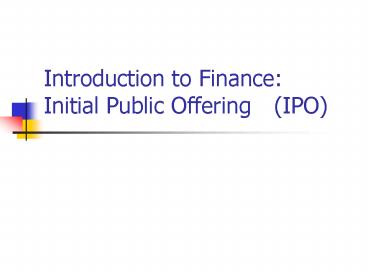Introduction to Finance: Initial Public Offering (IPO) - PowerPoint PPT Presentation
1 / 13
Title:
Introduction to Finance: Initial Public Offering (IPO)
Description:
Investors not familiar with the firm. ... underpriced then investors make a ' ... Angel: wealthy individuals who invest in the business. Jim Clark ($4.1 million) ... – PowerPoint PPT presentation
Number of Views:1990
Avg rating:3.0/5.0
Title: Introduction to Finance: Initial Public Offering (IPO)
1
Introduction to Finance Initial Public Offering
(IPO)
2
Why Go Public?
- Is going pubic simply a stage in the life cycle
of the firm? - It is a choice. A choice in financing.
- Positive effects must be balanced against the
negative effects. - Negative effects adverse selection problem,
large expenses, loss of confidentiality - Positive effects alternative financing
possibilities, increased bargaining power with
banks
3
Underwriter (Syndicate)
- Syndicate group of investment banks. Managing
bank (leading bank) organizes the syndicate. - Firm commitment syndicate (underwriters) commit
to buying shares and selling. Shares bought at
less than the offering price but the investment
bank accepts the risk of not being able to sell
the shares. The syndicate reduces the spreads the
risk across banks.
4
Cont.
- Green Shoe provision Members of the underwriting
group have the option to purchase additional
shares at the offering price. - Book Building Recent IPOs in Japan take this
approach. Estimate investor demand (taking into
account all facts and circumstances).
5
Positive Effects
- If future investments expected to increase
public offerings make funds available. - Firms with relatively large debt positions could
use the proceeds from the offering to reduce
debt exposure. - Better access to capital markets. Bargaining
power with banks could increase. - (current) Shareholders gain liquidity. Equity
based compensation schemes become possible.
6
Cont.
- Monitoring and information provided by the
market. - Enhance firms credibility.
7
Negative Effects
- In the event of an IPO, a small firm could face
information asymmetry. Investors not familiar
with the firm. - Loss of confidentiality For example, firms with
RD projects which they do not wish to disclose
to the public for competitive reasons. - Costs of dealing with shareholders costs of
operating a publicly traded firm (PR dept.,
audits, etc.)
8
Cont.
- Direct costs of IPO registration, underwriting
fees, etc. (total direct cost amount to
approximately 10 of amount raised). - Indirect Cost - underpricing problem.
9
Empirical Evidence
- Hiraki and Hebner (1993) document a 32 initial
return on average for IPOs during 1981-91. - Isobe, Ito, Kairys (1998) look at long-run
performance of IPOs and find less evidence of
deliberate underpricing. Their results appear
somewhat consistent with an over-reaction
hypothesis. However, they conclude that
instituional features in price setting (using
comparables) could be an important factor.
10
Understanding Underpricing
- 1) Underwriter incentives Avoid risk of not
being able to sell shares. - 2) Sequencing of issues. If the first issue is
underpriced then investors make a gain. They
might be more likely to subscribe to a firms
secondary offering because of their experience in
the IPO (primary offering).
11
Cont.
- 3) Underpricing induces the average investor to
buy. Informed investors are assumed to know the
true value of the share. Thus informed investors
will only purchase those valued shares which are
underpriced. The average investor, on the
other hand, will purchase across the board since
they do not know which shares are truly
underpriced.
12
Cont.
- However, the average investor will lose money (on
average). Realizing they do not have the same
information as the informed investor, the average
investor may choose not to enter the market.
Hence, to induce these average investors into the
market, the IPOs are underpriced.
13
Netscape
- The choice of going public need of substantial
funds for RD over next several years. - Saturated private funding
- Angel wealthy individuals who invest in the
business. Jim Clark (4.1 million) - Venture capital funds Kleiner, Perkins,
Caufield, Byers (5 million) - Bank Loans?































